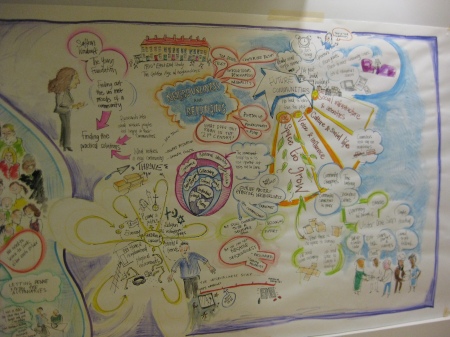These are my notes from the presentation by Saffron Woodcraft of The Young Foundation at the Sense of Place Conference.
The Young Foundation takes it’s name from Michael Young a social entrepreneur that worked in London.
The foundation carries out action research in communities and turns ideas into reality. A new program, Future Communities, looks at the social elements of planned new builds.
Saffrons questions: Neighbourliness and belonging – what are they and why are they important?
A sense of belonging can be experienced on 3 levels.
- Individual – family, friends and people close around us (strongest sense of belonging)
- Collective – wider networks, familiar strangers, professional networks
- National – shared values, governance (weakest sense of belonging)
Belonging becomes a bigger issue in more uncertain times. Feedback circuits of shared values and ideas have a connection to and an influence on belonging.
Some ways in which we get a sense of belonging include
- religion
- voluntary organisations
- home neighbourhood and the physical environment
- power and politics
- economy
- family and friends
There is a common assumption that we all used to be more neighbourly, but now we travel out of our neighbourhood for more and more things such a s work and shopping, and spend less time interacting in our neighbourhoods. there are more cars and less opem spaces for interaction.
But despite this people still have a strong idea that neighbourliness is a good thing.
Defining Neighbourliness:
Manifest – social interaction
– mutual help and exchange
Latent – feelings or inclinations toward neighbourliness when needed
The Manchester neighbourliness review defined neighbourliness as
- Awareness of the situation of other residents
- Respect their privacy
- Support when needed
There are many challenges and obstacles for new communities as communities and neighbourliness are established over time. Can help with
- social infrastructure and amenities
- culture and social life
- voice and influence
- space to grow
Things that help people to belong to a community include
- Greeters (people that specifically welcome new people to the community and help them with practical aspects – happens with migrants to Adelaide)
- Micro grants for neighbourhood projects to get started
- Places to meet
- Lots of information sources
A low cost example of bringing community together is from Haringey in London. Very divers and transient community. Project “Under One Sun” invites people from across the community to come together and cook for each other – over the sharing of food they talk about where they are from, their fears and anxieties and what they are looking for from their community.
The following image is a photograph of the visual minutes taken at the conference


You must be logged in to post a comment.